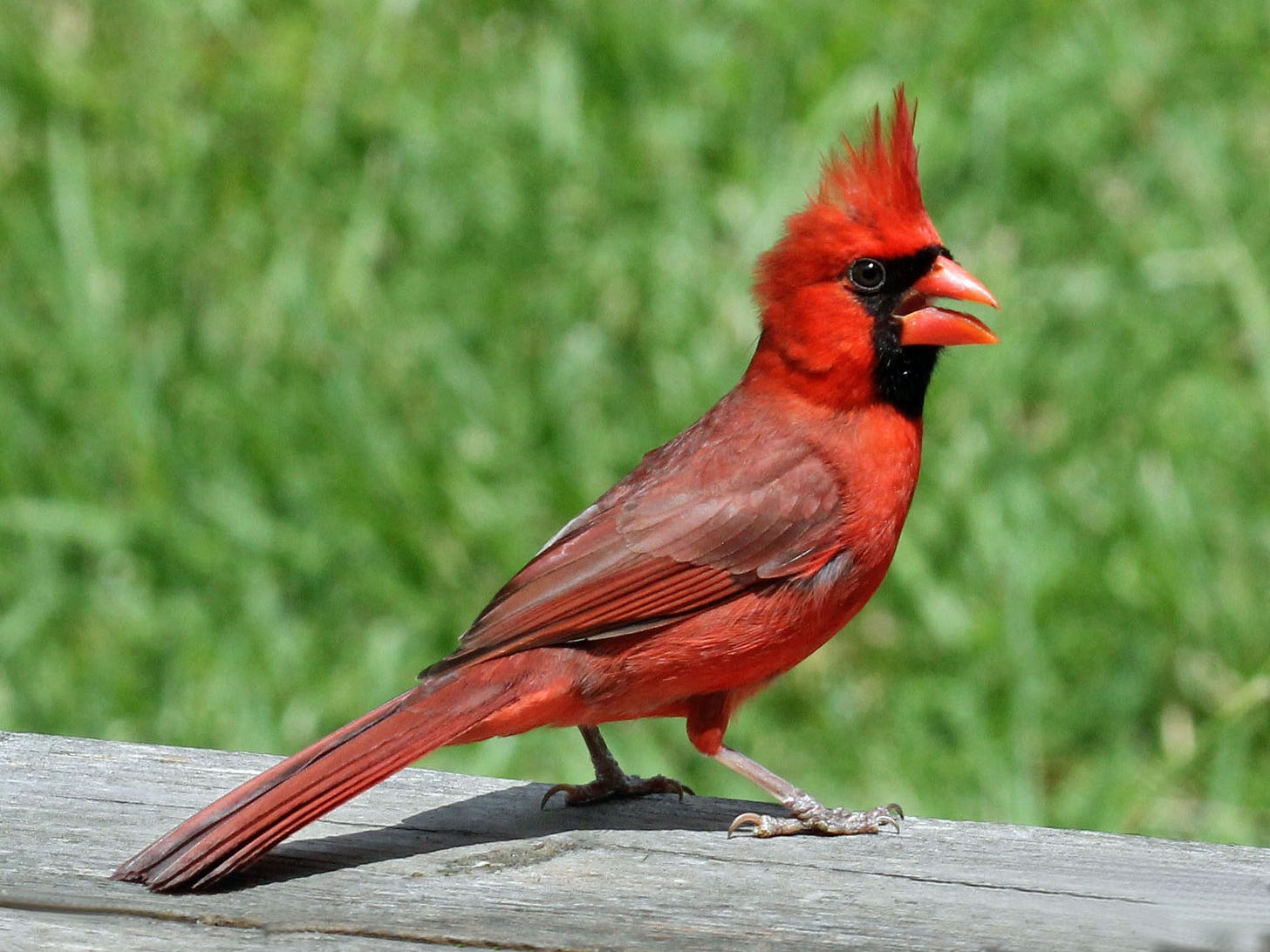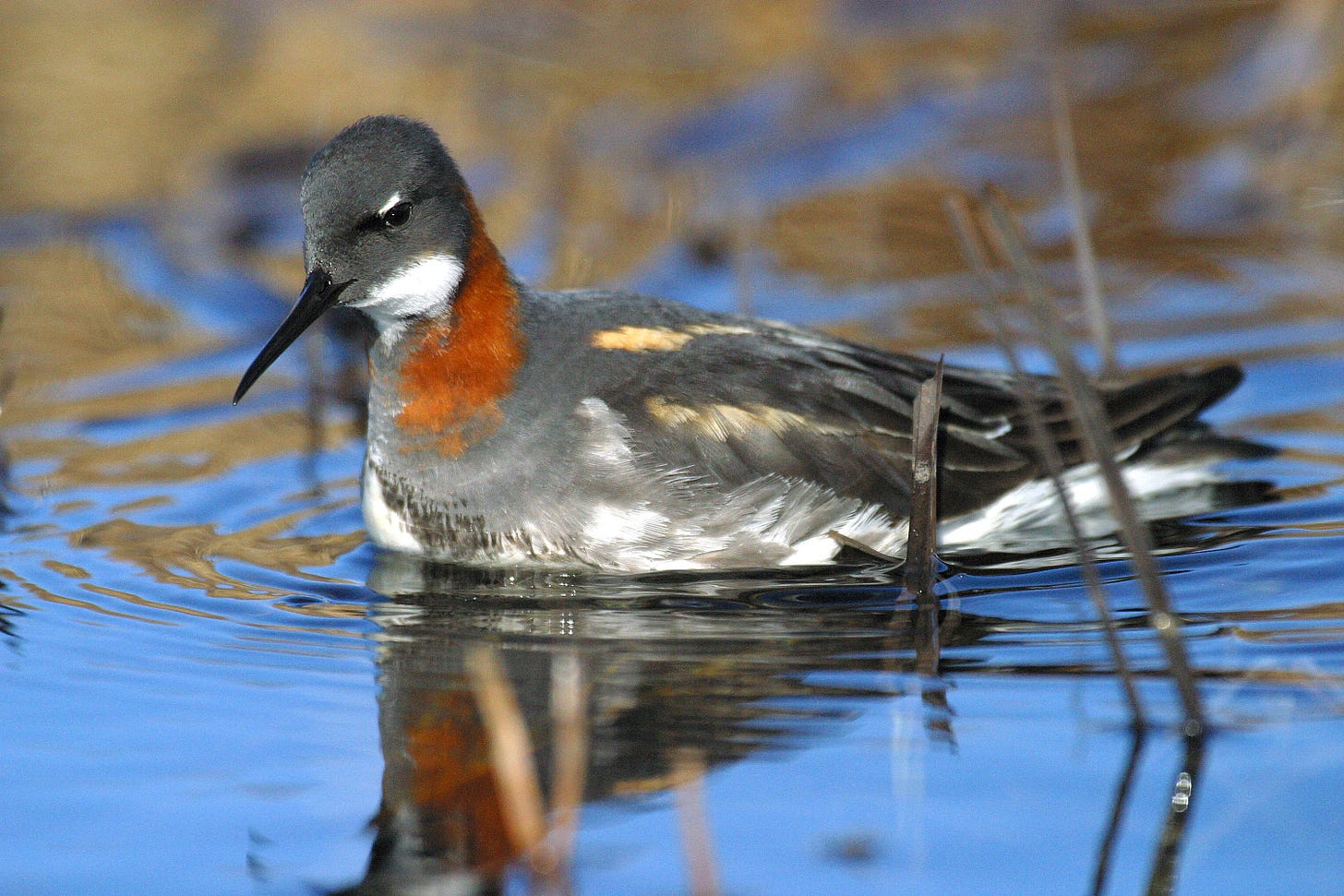
1. A problem
We live in Jurassic Park — literal dinosaurs flit and flirt around us! — but somehow schools pay them little attention.
2. Basic plan
Starting in elementary school, introduce kids to 40 kinds of local birds.
Focus on memory, but make it interesting. For each species, share an odd detail or two, and some amazing photos. See who can come the closest to making the bird’s sounds, and (when possible) learn what the sounds mean. (How a cardinal says “a cat! it’s a cat! EVERYBODY, THERE’S A CAT!!!” is quite different from how it says “I’m sexxxxxxxy”.)
Help kids make a notebook of these birds, where they record facts from the perspective of the birds themselves. Write down the common name, any indigenous names you can find, and the Latin name — and what the heck these all mean.
Use this as the start to unraveling the world of birds.
3. What you might see
In the middle of a quiet spelling test, a kid suddenly pointing out the window and shouting OH MY GOSH IT’S A RED-NECKED PHALAROPE! and everyone — the teacher included — dropping their work to run to the window.
4. Why?
Our imaginations are divorced from our local ecosystems: many animal-savvy kids can tell you more about whale sharks or tardigrades or T-rexes than about any animal they see around them. Meanwhile, wild animals surround us!
Notably, wild animals that are sometimes threatened. Lots of bird species are doing just fine, but quite a few are diminishing. We need an education that will help us connect to our locale. And the more interesting the local world becomes, the more we’ll want to protect it.
5. Egan’s insight
Where do we see this in the human experience?
No one in a hunter-gatherer band could afford to be ignorant of their local animals, and the relationships they had with these animals were often the foundation of how they saw the world.
How might this build different kinds of understanding?
We want to help kids 🤸♀️IMITATE and forge 🤸♀️RELATIONSHIPS with birds. To help in this, we need to care about getting their 🧙♂️NAMES right — and understanding that each name means something. We should help kids make a 🦹♂️COLLECTION of all the kinds of birds they’ve learned, and to remember it.
But, as Ralph Waldo Emerson wrote,
The bird is not in its ounces and inches,
but in its relations to Nature.
Ultimately, we’re not just aiming to amass details, but see how birds connect with the world around them. Eventually, each bird will become a node in multiple 👩🔬SYSTEMS — a food chain, an evolutionary lineage, social hierarchies, and so on. And trying to really understand these systems from the bird’s perspective will push us past what we’re able to understand, and bring us to 😏APPRECIATION OF AMBIGUITY. (What do these weird emoji mean?)
6. This might be especially useful for…
People who really should know more about birds.
7. Critical questions
Q: Forty’s a lot. Why so many?
There are a lot of birds around you — more than you might realize.
You’ve got your finches and your cardinals and your warblers. You’ve got your corvids (crows, ravens, jays) and your blackbirds (a group evolutionarily distinct from corvids — and which include the orange orioles). You have thrushes. (No one ever talks about “thrushes”, but the American robin is their preening rock star, and the bluebird is their J.D. Salinger.1)
That’s just songbirds.
There are also ducks and geese, and gulls and shorebirds. There are the raptors (any number of hawks, eagles, ospreys, falcons, and the loathsome vultures). God help us all, we haven’t even mentioned owls!
Again: there are a lot of birds around you. (I missed pigeons and doves, didn’t I? Also, my list here is based on the birds in southeastern Minnesota — you probably have even cooler birds by you.2) “Forty” sounds like a big number, but it’s around the minimum number to recognize most of the cool-looking birds that you see.
Q: How quickly should you do them?
I’m not sure.
If you spread them out (say, two a week for a year, or three a week for a semester), you’ll have lots of chances to review as you go. If you pack them in (one a day), you’ll build the excitement of birding — because people feel powerful when they can actually name the birds they see.
I’m open to creative solutions to this tension.
Q: What should the notebooks look like?
To start, I’d suggest taking a spread of two pages for each type of bird. Write the common name at the top of the left-hand page, and save the rest for drawings, what it eats and what it fears, other names, cool trivia, observations, and questions.
Can you tell this pattern is undercooked? It’s undercooked — while I’ve done things like it with kids, I haven’t done this specifically. Probably you can help flesh this out — subscribe, and join the comments conversation!
8. Physical space
At home
If you’ve ever found yourself wondering, “should I invest in a good bird feeder?” you can let this nudge you over the edge. Also, look at rummage sales for a used birdbath.
If your kid is young, you might also consider purchasing The Little Book of Backyard Bird Songs. You also will want to download the Merlin Bird ID app, which is (as its name so cleverly hints) magic.
If you really get into this, you’ll probably want to pick up a cheap pair of binoculars.
In a classroom
There’s nothing that local conservation groups love to do more than producing posters of local birds (just Google “backyard birds of _____ poster”); hang more than one in your room. (None are complete, and you want to signal this to the kids.) You also might consider having a classroom tablet loaded with the Merlin Bird ID app.
9. Who else is doing this?
Outdoor schooling — aka forest school, aka wilderness education — often does a great job of this. (Side note: do we have any readers in that community? If so, I’d love to connect and pick your brains.3)
How might we start small, now?
Throw this into ChatGPT:
Act as an avid birdwatcher who's great at talking simply to the bird-illiterate public.
In a moment, I'm going to tell you where I live and what season it is; I want you to create a table of ten of the most common and interesting birds I might see around me. In separate columns, tell me their common name, their scientific name, an indigenous name, one thing the bird eats, an animal that is a predator to the bird, and something amazing about the bird. (For the indigenous name, tell me a name given to the bird by a Native American/First Nations/indigenous tribe; include the pronunciation.)
Okay: now ask me for where I live, and the season.Take a read of this eye-opening recent essay in the Times by science writer Ed Yong —
When I Became a Birder, Almost Everything Else Fell Into Place
He tells of how taking up bird-watching has changed his life. One quote:
To find the birds, you have to know them. And in the process of knowing them, much else falls into place.
Aaaaand download the Merlin Bird ID app. (Have I mentioned it yet? It’s really that good!)
10. Related patterns
This is parallel to Local Bugs°, Local Trees°, and Local Flowers°; all of these are important pieces of Know a Place°. It’s the opposite of Dinosaurs & Aliens & Sharks O My° (which leverages kids’ excitement at the “exotic”.)
We can use the tools of Making Noise° to emulate the sounds birds make, which can lead us into Be the Creature°, in which kids try to imagine the subjective experience of an organism.
Memory cards that you make for birds would be excellent fuel for a Forgetting Curve Box°.
Many birds wander far; this adds purpose to Geography by Heart°. Learning that the Canada Goose outside the window probably spent her summer in the Arctic, or that the yellow warbler is preparing to winter in South America, makes those places real to a student.
Afterword:
Did you know this year’s Astral Codex Ten book review contest has begun? There’s still a week and change to read some wonderful reviews, and vote for your favorites! I find it a wonderful way to get the gist of book I’ve wanted to pick up, and more — to get an intelligent take on them. Recommended.
Maybe you often see bluebirds where you live? I don’t know how many bluebird houses I’ve built; I only ever see robins.
That’s false humility, there — my local birds could definitely beat up your local birds.
“Pick your brains” is always an iffy phrase, all the more so in a post that’s already brought up vultures.






https://www.goodreads.com/book/show/886449.The_Boy_Who_Drew_Birds
This short biography of John James Audubon is an annual hit with my 1-3rd graders. Students are inspired to sketch and observe.
For those in the United States, I recommend the "Birds of [your state here]" guidebooks by Stan Tekiela. The best thing about them is that they're organized by color and then by size, making it easy to look up the unfamiliar bird you just saw.